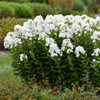Phlox paniculata 'Backlight' - GARDEN PHLOX 'BACKLIGHT' (TALL PHLOX)
"Improved" version of Phlox paniculata ‘David' with regular, upright clumps.
Makes a great cut flower.
Good resistance to powdery mildew. Pure white flowers bloom in midsummer atop 3′ tall stems.
Tall phloxes flower for a long period of time, but deadheading or performing a "Chelsey chop" will prolong the blooming time even more.
Blooming Time: mid to late summer, with reblooming in the fall
Size: 28-30" tall x 20-24" wide, spacing 1.5’
USDA Zones: 3 to 8
Culture: full sun, half sun, light shade grows well in average soil, prefers good soil enriched with compost or other organic material and occasional fertilizing. Loamy, rich soils with enough moisture. Spot with good air circulation to prevent mildew is recommended.
Moisture Needs: medium (average) to medium moist
Origin: Introduced by Walters Gardens (Zeeland, MI), part of LUMINARY® Collection and Proven Winner. Patented plants under PP34506. See the distribution of the wild species of Phlox paniculata on the map of USDA.
Black Walnut Tolerant: yes
Deer/Rabbit Resistant: no / no, some protection needed (deer and rabbit repellent, fence)
Attracts Butterflies or Pollinators: some butterflies, some bees
Attracts Hummingbirds: yes
Pot Size: round Proven Winner quart (4.23" x 5" tall)
Plant Combinations: Best in flower beds, both private and public landscaping projects,cottage gardens, hummingbird and butterfly gardens or some naturalization. As with any other tall garden phlox, it's best to place it in the center of the flower bed, because the stems naturally loose their leaves, so plant some lower perennials in front of them
Beautiful combinations can be reached combining with yellow, cream, white, orange yellow or pink flowers. If you go native (or nativar) style of planting, we highly suggest these perennials: Agastache (tall blue or bluish flowering, Agastache ‘Black Adder‘ ), lower varieties of Coreopsis tripteris, Echinacea purpurea, Echinacea tennesseensis, Eupatorium, Filipendula rubra ‘Venusta‘ or wild form, Helenium, Monarda didyma, other varieties of Phlox paniculata, Rudbeckia maxima, Rudbeckia fulgida, annual R. hirta, Veronicastrum or cultivars of grass Panicum virgatum.
Good non-native perennial combinations include Astilbe chinensis (taller varieties), Astrantia major, Delphinium, Geranium, Geum x hybridum, Hemerocallis, Leucanthemum superbum, Lilium, Persicaria amplexicaulis, Sanguisorba, Scabiosa caucasica or Thalictrum.
Very charming in combination with nativars of native shrub – Hydrangea arborescens or non-native Hydrangea paniculata or some roses in the background.
Picture Copyright: Walters Gardens

Phlox paniculata 'Backlight' - GARDEN PHLOX 'BACKLIGHT' (TALL PHLOX)
"Improved" version of Phlox paniculata ‘David' with regular, upright clumps.
Makes a great cut flower.
Good resistance to powdery mildew. Pure white flowers bloom in midsummer atop 3′ tall stems.
Tall phloxes flower for a long period of time, but deadheading or performing a "Chelsey chop" will prolong the blooming time even more.
Blooming Time: mid to late summer, with reblooming in the fall
Size: 28-30" tall x 20-24" wide, spacing 1.5’
USDA Zones: 3 to 8
Culture: full sun, half sun, light shade grows well in average soil, prefers good soil enriched with compost or other organic material and occasional fertilizing. Loamy, rich soils with enough moisture. Spot with good air circulation to prevent mildew is recommended.
Moisture Needs: medium (average) to medium moist
Origin: Introduced by Walters Gardens (Zeeland, MI), part of LUMINARY® Collection and Proven Winner. Patented plants under PP34506. See the distribution of the wild species of Phlox paniculata on the map of USDA.
Black Walnut Tolerant: yes
Deer/Rabbit Resistant: no / no, some protection needed (deer and rabbit repellent, fence)
Attracts Butterflies or Pollinators: some butterflies, some bees
Attracts Hummingbirds: yes
Pot Size: round Proven Winner quart (4.23" x 5" tall)
Plant Combinations: Best in flower beds, both private and public landscaping projects,cottage gardens, hummingbird and butterfly gardens or some naturalization. As with any other tall garden phlox, it's best to place it in the center of the flower bed, because the stems naturally loose their leaves, so plant some lower perennials in front of them
Beautiful combinations can be reached combining with yellow, cream, white, orange yellow or pink flowers. If you go native (or nativar) style of planting, we highly suggest these perennials: Agastache (tall blue or bluish flowering, Agastache ‘Black Adder‘ ), lower varieties of Coreopsis tripteris, Echinacea purpurea, Echinacea tennesseensis, Eupatorium, Filipendula rubra ‘Venusta‘ or wild form, Helenium, Monarda didyma, other varieties of Phlox paniculata, Rudbeckia maxima, Rudbeckia fulgida, annual R. hirta, Veronicastrum or cultivars of grass Panicum virgatum.
Good non-native perennial combinations include Astilbe chinensis (taller varieties), Astrantia major, Delphinium, Geranium, Geum x hybridum, Hemerocallis, Leucanthemum superbum, Lilium, Persicaria amplexicaulis, Sanguisorba, Scabiosa caucasica or Thalictrum.
Very charming in combination with nativars of native shrub – Hydrangea arborescens or non-native Hydrangea paniculata or some roses in the background.
Picture Copyright: Walters Gardens


